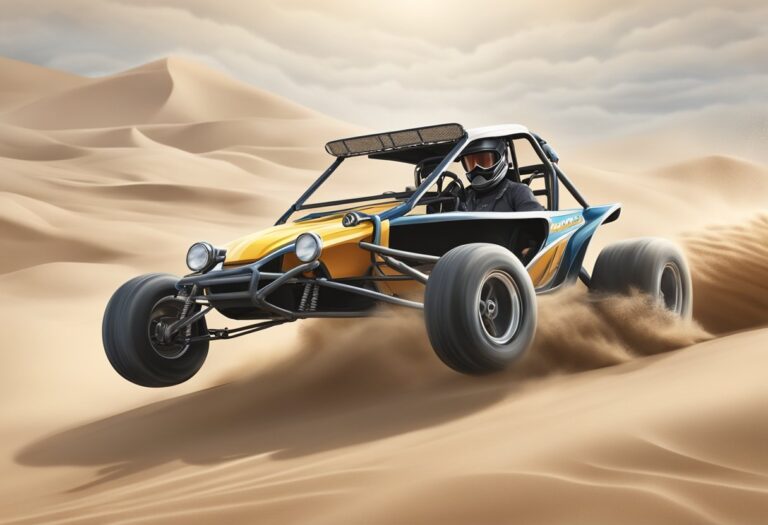Sand Rail vs Dune Buggy: A Comparison of Off-Road Vehicles

Sand rails and dune buggies are two types of off-road vehicles that are often used in sandy terrains such as deserts and beaches. While they may look similar at first glance, there are some key differences between the two that make them unique.
Sand rails are lightweight, tube-framed vehicles that are designed specifically for off-road use. They typically have rear-wheel drive and wide, paddle-style tires that provide excellent traction on sand. On the other hand, dune buggies are often based on modified Volkswagen Beetle chassis and have front-wheel drive. They are generally heavier than sand rails and have smaller, knobby tires that are better suited for rocky terrain.
The historical development of sand rails and dune buggies is also quite different. Sand rails were originally designed for racing and were popularized in the 1960s and 1970s. Dune buggies, on the other hand, were developed as a recreational vehicle and gained popularity in the 1960s as a fun and affordable way to explore off-road environments. Today, both sand rails and dune buggies are popular among off-road enthusiasts and can be highly customized to suit individual needs and preferences.
Key Takeaways
- Sand rails and dune buggies are two types of off-road vehicles that are designed for use in sandy environments.
- Sand rails are lightweight, tube-framed vehicles with rear-wheel drive and wide, paddle-style tires, while dune buggies are often based on modified Volkswagen Beetle chassis and have front-wheel drive with smaller, knobby tires.
- Sand rails were originally designed for racing, while dune buggies were developed as a recreational vehicle and gained popularity in the 1960s. Both vehicles can be highly customized to suit individual needs and preferences.
Defining Sand Rails and Dune Buggies
Sand rails and dune buggies are both off-road vehicles that are designed to navigate through sandy terrains. However, there are some fundamental differences between the two that are important to understand before deciding which one to buy.
Sand Rails
A sand rail is a lightweight off-road vehicle that is designed specifically for use in sandy terrain. Sand rails typically feature a tubular steel frame, an open cockpit, and large, paddle-style tires that provide excellent traction in sand. They are usually powered by high-performance engines that are capable of producing a lot of horsepower, which allows them to reach high speeds over sand dunes.
Sand rails are often used for racing or for recreational purposes, and they can be customized to suit individual preferences. They are typically more expensive than dune buggies, but they offer superior performance and handling in sandy terrain.
Dune Buggies
A dune buggy is a recreational vehicle that is designed to be driven on sand dunes or beaches. They are typically built on a shortened chassis of a Volkswagen Beetle or similar car and feature an open cockpit, large tires, and a roll cage for safety. Dune buggies are usually powered by air-cooled engines that are not as powerful as those found in sand rails.
Dune buggies are generally less expensive than sand rails, and they are often used for recreational purposes such as cruising along the beach or exploring sand dunes. They are not as fast or powerful as sand rails, but they are still capable of providing a fun and exhilarating off-road experience.
Historical Development
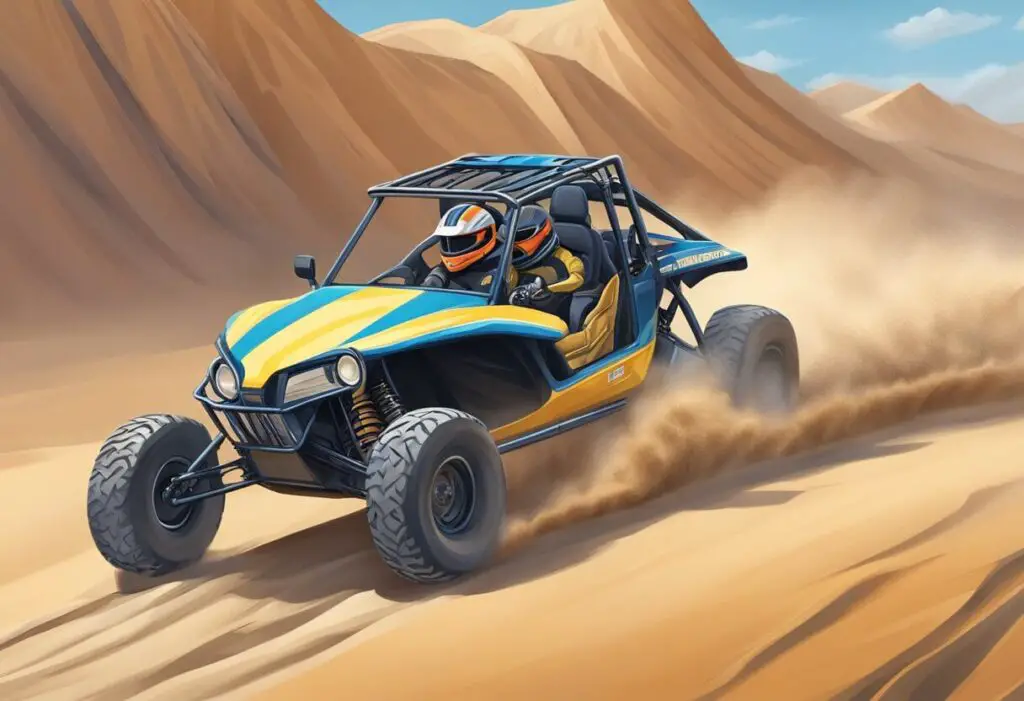
Sand rails and dune buggies have a rich history that dates back several decades. In this section, we will explore the origins and evolution of these off-road vehicles.
Origins of Sand Rails
Sand rails originated from the need for lightweight vehicles that could navigate the sandy terrain of the desert. In the 1960s, enthusiasts began to modify Volkswagen Beetles and other cars to create sand rails. These vehicles were stripped down to their frames and fitted with custom-built suspension systems, engines, and tires. The result was a lightweight, high-performance vehicle that could handle the rough terrain of the desert.
Evolution of Dune Buggies
Dune buggies, on the other hand, were developed as a recreational vehicle for beachgoers. In the 1950s, Californian surfers began to modify their cars to create beach buggies. These vehicles were designed to be lightweight and compact, allowing them to navigate the sandy beaches of California. As the popularity of beach buggies grew, manufacturers began to produce purpose-built dune buggies.
Over time, dune buggies evolved to become more powerful and versatile. They were fitted with larger engines and more advanced suspension systems, allowing them to handle a wider range of terrain. Today, dune buggies are popular recreational vehicles that can be used for everything from racing to off-road adventures.
Design and Construction
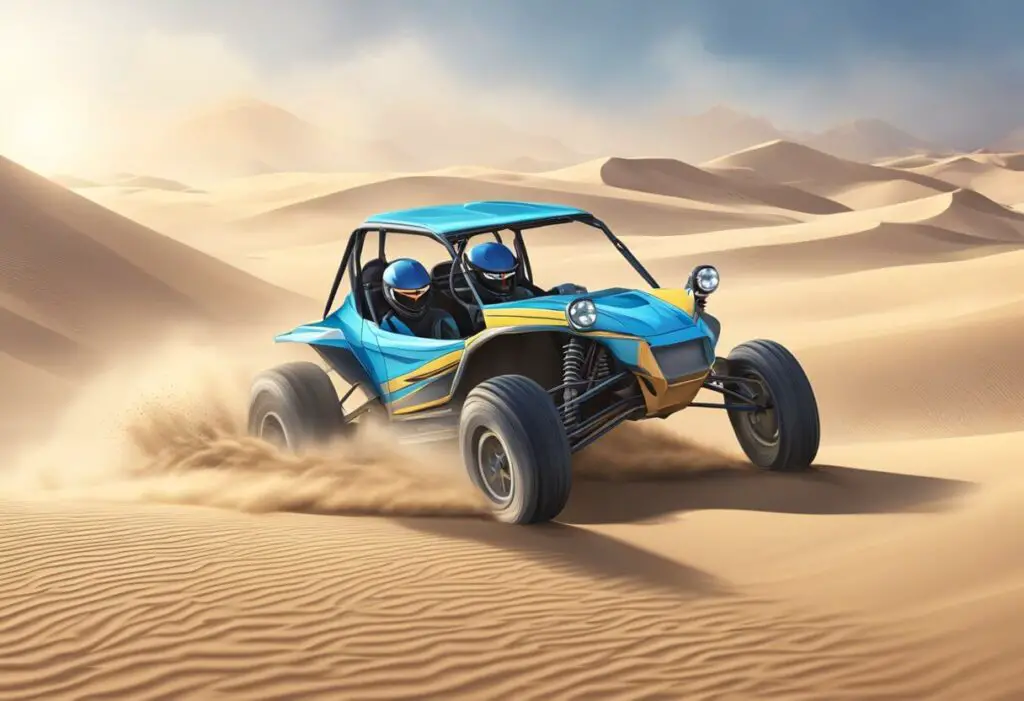
Chassis and Bodywork
Sand rails and dune buggies have different designs and construction. Sand rails have a tubular chassis, which is lightweight and provides a strong foundation for the vehicle. The chassis is usually made of chromoly steel, which is strong and can withstand the rigors of off-road driving. The bodywork of sand rails is minimal and usually consists of a roll cage and a few panels to protect the driver and passengers.
On the other hand, dune buggies have a more traditional car-like design, with a body that covers the chassis and provides more protection for the driver and passengers. The bodywork is usually made of fiberglass, which is lightweight and can be molded into different shapes and designs.
Engine and Transmission
Sand rails and dune buggies also differ in terms of their engines and transmissions. Sand rails are usually powered by high-performance engines, such as Volkswagen or Subaru engines, that are specifically designed for off-road use. These engines are typically air-cooled and have a high power-to-weight ratio, which makes them ideal for sand rail applications.
Dune buggies, on the other hand, are often powered by smaller engines, such as four-cylinder or six-cylinder engines, that are typically water-cooled. These engines are usually less powerful than those used in sand rails, but they are more fuel-efficient and can provide a smoother ride.
In terms of transmissions, sand rails and dune buggies can be equipped with either manual or automatic transmissions. Sand rails often use manual transmissions, such as four-speed or five-speed gearboxes, that are designed for off-road use. Dune buggies, on the other hand, are often equipped with automatic transmissions, such as three-speed or four-speed gearboxes, that are more suited for on-road use.
Performance Capabilities
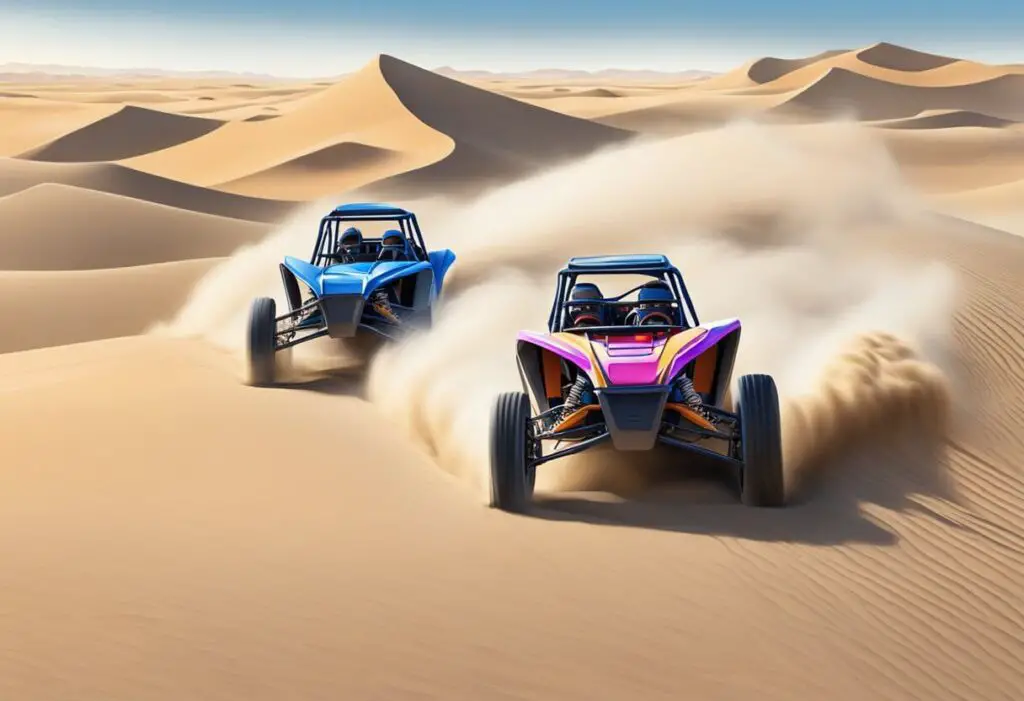
Terrain Handling
When it comes to terrain handling, both sand rails and dune buggies are designed to handle off-road terrains with ease. Sand rails are particularly designed for sand-filled areas and are equipped with wide tires that provide excellent traction on sandy surfaces. On the other hand, dune buggies are designed to handle a variety of terrains including sand, dirt, and gravel.
Sand rails are particularly good at handling steep inclines and declines due to their lightweight construction and powerful engines. They are also equipped with long-travel suspension systems that provide excellent shock absorption and stability on rough terrains. Dune buggies, on the other hand, are designed to handle a variety of terrains and are equipped with robust suspension systems that provide excellent stability and control on uneven surfaces.
Speed and Acceleration
Both sand rails and dune buggies are designed for speed and acceleration. Sand rails are equipped with powerful engines that can generate high speeds, making them ideal for racing and high-speed off-road adventures. They are also designed to be lightweight, which makes them more agile and responsive on the sand.
Dune buggies, on the other hand, are designed for speed and acceleration on a variety of terrains. They are equipped with powerful engines that can generate high speeds, making them ideal for racing and off-road adventures. They are also designed to be more stable and responsive on uneven surfaces, which makes them more versatile than sand rails.
Usage and Popularity
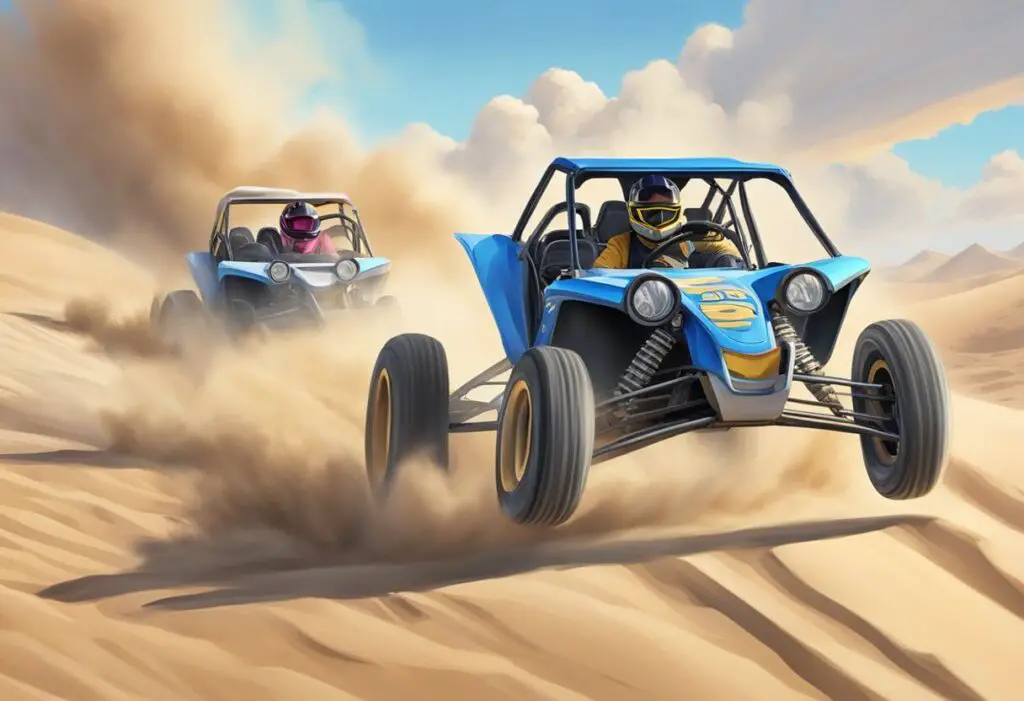
Sand rails and dune buggies are both popular off-road vehicles that are designed for use on sand dunes and other sandy terrains. They are both used for recreational purposes as well as for racing and competitions.
Recreational Use
Both sand rails and dune buggies are popular for recreational use, particularly in areas with large sand dunes. They are often used for exploring the dunes, sand surfing, and other fun activities.
Sand rails are generally preferred for more extreme off-roading due to their higher power-to-weight ratio and better suspension. They are also more stable at high speeds and can handle rougher terrain.
Dune buggies, on the other hand, are more popular for casual recreational use. They are generally less powerful than sand rails and have a simpler design. However, they are still capable of handling sand dunes and other sandy terrains.
Racing and Competitions
Sand rails and dune buggies are also popular for racing and competitions. There are various types of races and competitions that are specifically designed for these vehicles.
Sand rails are often used in desert racing, which is a type of off-road racing that takes place in the desert. They are also used in sand drag racing, which is a type of drag racing that takes place on sand.
Dune buggies are often used in sand drags and other types of off-road racing. They are also used in hill climb competitions, which involve racing up steep hills.
Customization and Modifications

Aftermarket Support
Both sand rails and dune buggies have a wide range of aftermarket support, allowing enthusiasts to customize and modify their vehicles to their liking. From suspension upgrades to engine modifications, there are plenty of options available for those looking to enhance the performance and aesthetics of their off-road vehicles.
Sand rails, in particular, have a strong aftermarket community due to their popularity in the off-road racing scene. Many manufacturers offer bolt-on parts and kits specifically designed for sand rails, including long-travel suspension systems, high-performance engines, and lightweight body panels.
Dune buggies, on the other hand, have a more diverse aftermarket support due to their versatility as dual-purpose vehicles. Many companies offer parts and accessories for both on-road and off-road use, such as street-legal lighting kits, roll cages, and sound systems.
DIY Custom Builds
For those who prefer a more hands-on approach, both sand rails and dune buggies offer endless possibilities for DIY custom builds. With a little bit of creativity and some basic fabrication skills, enthusiasts can create one-of-a-kind vehicles that reflect their personality and style.
Sand rails, in particular, lend themselves well to DIY custom builds due to their minimalistic design. Many builders opt to start with a bare chassis and build up from there, selecting components and parts that fit their specific needs and preferences.
Dune buggies, on the other hand, often start with a pre-existing car frame, which can limit the customization options to some extent. However, with some creativity and ingenuity, builders can still create unique and personalized vehicles that stand out from the crowd.
Overall, both sand rails and dune buggies offer plenty of opportunities for customization and modifications, allowing enthusiasts to create vehicles that are truly their own. Whether you prefer bolt-on upgrades or DIY custom builds, there are plenty of options available to help you achieve your off-road dreams.
Safety and Regulations
Safety Features
Both sand rails and dune buggies are designed for off-road use, and as such, safety features are crucial to ensure the protection of the driver and passengers. Some of the safety features that are common in both sand rails and dune buggies include roll cages, safety harnesses, and helmets.
Roll cages are essential in protecting the occupants in the event of a rollover. Dune buggies usually have a welded roll cage, while sand rails have a bolt-on roll cage that is removable for maintenance purposes. Safety harnesses, on the other hand, keep the occupants securely seated in the vehicle during off-road driving. Helmets protect the occupants’ heads from injury in the event of an accident.
In addition to these basic safety features, some sand rails and dune buggies may have additional safety features such as fire extinguishers, first aid kits, and communication devices.
Legal Considerations
When it comes to legal considerations, sand rails and dune buggies are subject to different regulations depending on the state or country where they are used. In some states, sand rails and dune buggies are not street legal and can only be used on private property or designated off-road areas.
To be street legal, sand rails and dune buggies must meet certain requirements such as having seat belts, turn signals, headlights, and brake lights. Additionally, they must pass safety inspections and emissions tests.
It is important to research and understand the legal requirements in your area before purchasing or operating a sand rail or dune buggy. Failure to comply with legal requirements can result in fines, impounding of the vehicle, or even criminal charges.
In summary, safety features and legal considerations are important factors to consider when choosing between a sand rail and a dune buggy. It is crucial to prioritize safety and ensure compliance with legal requirements to avoid any potential legal issues.
Cost Considerations
Initial Investment
When it comes to the initial investment, sand rails tend to be more expensive than dune buggies. According to the search results, sand rails can cost anywhere from $10,000 to $50,000 or more, depending on the make and model. On the other hand, dune buggies are generally less expensive, with prices ranging from $5,000 to $20,000 or more.
Maintenance and Repairs
When it comes to maintenance and repairs, both sand rails and dune buggies require regular upkeep to keep them running smoothly. However, the cost of maintenance and repairs can vary depending on the make and model of the vehicle, as well as the extent of the repairs needed.
Sand rails tend to have more complex engines and systems, which can make repairs more expensive. Additionally, sand rails require specialized tires that can be costly to replace. On the other hand, dune buggies tend to have simpler engines and systems, which can make repairs less expensive. Dune buggies also use standard off-road tires, which are generally less expensive than the specialized tires used by sand rails.
In conclusion, the initial investment and cost of maintenance and repairs are important factors to consider when deciding between a sand rail and a dune buggy. While sand rails tend to be more expensive upfront and may require more costly repairs, they offer a more specialized and high-performance off-road experience. Dune buggies, on the other hand, are generally less expensive and easier to maintain, making them a good choice for those on a budget or looking for a more casual off-road experience.





